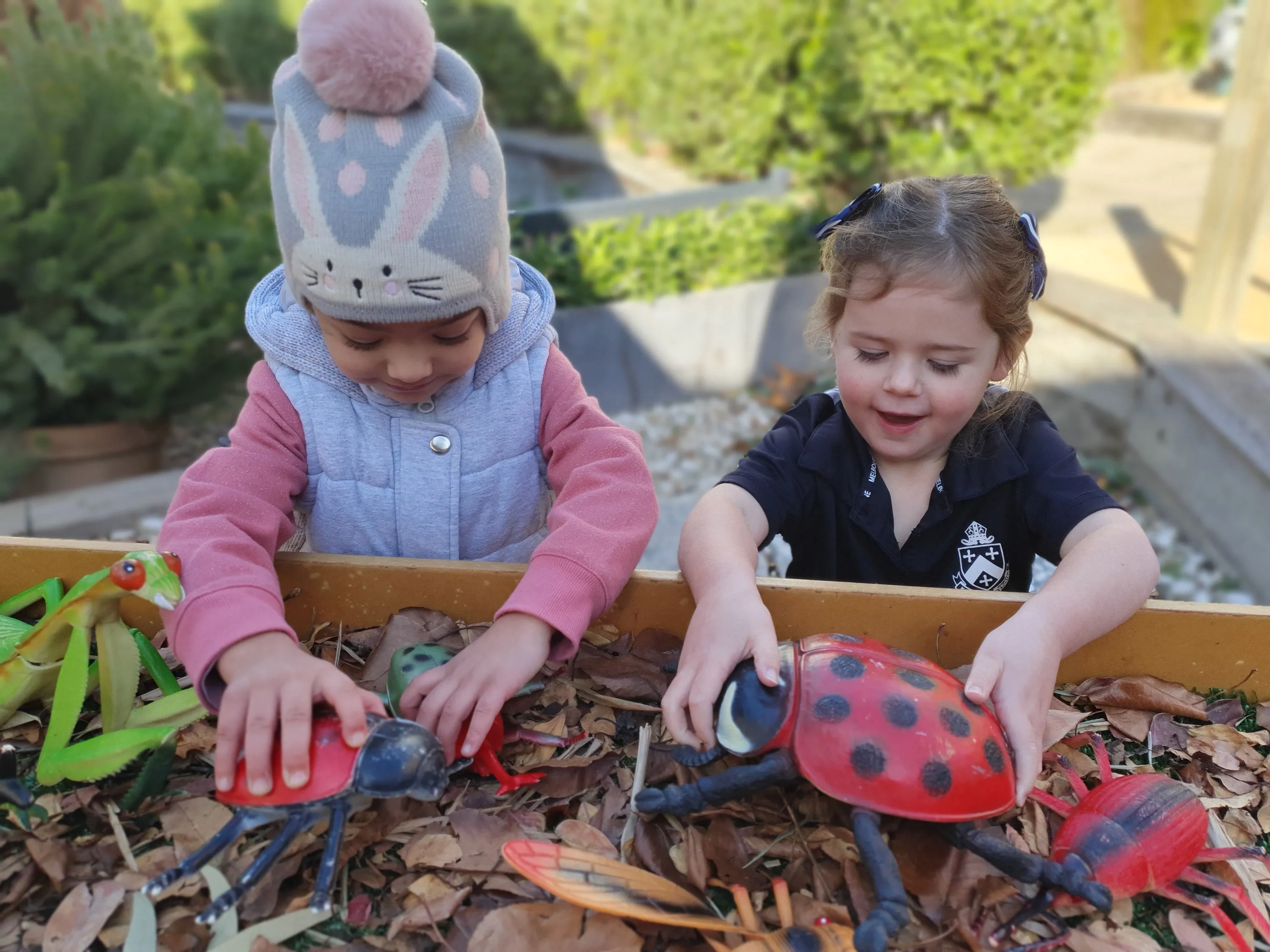%20portrait.webp)
%20portrait.webp)
Ayla-Rose, a curious learner in Prep examines materials through a microscope
%20portrait.webp)
%20portrait.webp)
Ayla-Rose, a curious learner in Prep examines materials through a microscope
Inspiring Future Innovators
In a bid to meet the future with the everchanging growth in innovation by industries around the world, Science, Technology, Engineering and Mathematics (STEM) has become the answer to advancement. The only problem is that the ratio of women to men within STEM has never been equal, no matter that women are as capable, intelligent and creative.
The reasons for this divide have been linked to as early as infancy, where subconscious toy choices unwittingly give boys the toys that promote problem solving and critical thinking.
In a research paper from the Alliance of Girls’ Schools Australasia titled ‘Re-think the pink’: Girls’ body image and career preferences influenced by gendered toys (1), the paper addresses how toys and internet games impact on women’s future career choices. This paper addresses the recently signed charter between the French government and key toy industry bodies to provide a “balanced representation in toys”, in the belief that gendered toys discourage girls from careers in STEM.
While we’re all highly aware of the low numbers of women currently pursuing STEM careers, the games and toys children play with aren’t all to blame. Even well meaning parents can inadvertently project their gender bias onto their daughters.
So how do we overcome society's ideas of what a woman can and should be?

The Right Environment
It starts with the right learning environment, such as ours at Melbourne Girls Grammar, where our Grammarians can be free to challenge gender stereotypes, find their confidence and understand that they can do anything. It’s also about having positive female role models who can help our students understand the diverse career opportunities available, that they can do anything they set their minds to.
Research from the Institution of Engineering and Technology found that just 26 per cent of girls are looking to pursue a career in STEM compared to 43 per cent of boys when they surveyed 13-23 year olds (2).
At Melbourne Girls Grammar, we pride ourselves on the challenges and opportunities we create for students to provide them with the chance to test and try and see what they like and don’t like, whether that’s subjects, co-curricular activities, interest areas or extension programs. Stereotypes and barriers do not exist at the School as we encourage our Grammarians, no matter their passion or interests, to be resilient and persevere.
The foundation of the cultural framework that exists at Melbourne Girls Grammar is one formulated on embedding lived values as well as to respect, celebrate difference and thrive in a diverse community of active and engaged learners. We work hard to rid our community of gender specific bias.
The Right Environment
It starts with the right learning environment, such as ours at Melbourne Girls Grammar, where our Grammarians can be free to challenge gender stereotypes, find their confidence and understand that they can do anything. It’s also about having positive female role models who can help our students understand the diverse career opportunities available, that they can do anything they set their minds to.
Research from the Institution of Engineering and Technology found that just 26 per cent of girls are looking to pursue a career in STEM compared to 43 per cent of boys when they surveyed 13-23 year olds (2).
At Melbourne Girls Grammar, we pride ourselves on the challenges and opportunities we create for students to provide them with the chance to test and try and see what they like and don’t like, whether that’s subjects, co-curricular activities, interest areas or extension programs. Stereotypes and barriers do not exist at the School as we encourage our Grammarians, no matter their passion or interests, to be resilient and persevere.
The foundation of the cultural framework that exists at Melbourne Girls Grammar is one formulated on embedding lived values as well as to respect, celebrate difference and thrive in a diverse community of active and engaged learners. We work hard to rid our community of gender specific bias.
The Right Environment
It starts with the right learning environment, such as ours at Melbourne Girls Grammar, where our Grammarians can be free to challenge gender stereotypes, find their confidence and understand that they can do anything. It’s also about having positive female role models who can help our students understand the diverse career opportunities available, that they can do anything they set their minds to.
Research from the Institution of Engineering and Technology found that just 26 per cent of girls are looking to pursue a career in STEM compared to 43 per cent of boys when they surveyed 13-23 year olds (2).
At Melbourne Girls Grammar, we pride ourselves on the challenges and opportunities we create for students to provide them with the chance to test and try and see what they like and don’t like, whether that’s subjects, co-curricular activities, interest areas or extension programs. Stereotypes and barriers do not exist at the School as we encourage our Grammarians, no matter their passion or interests, to be resilient and persevere.
The foundation of the cultural framework that exists at Melbourne Girls Grammar is one formulated on embedding lived values as well as to respect, celebrate difference and thrive in a diverse community of active and engaged learners. We work hard to rid our community of gender specific bias.



Students are challenged to think about things in different ways, while exceptional educators maximise the potential of every student by tailoring the learning program to suit interests, challenges, and strengths. We provide engaging hands on learning experiences to build knowledge of the world, and develop competencies as active and curious learners.
“With the COVID global pandemic, more than ever, there has been a shift to broaden the talent pool and build a stronger workforce with the proficiencies and skills that are reflective of a STEM education,” said Principal Dr Toni Meath.
We are lucky that in our community of staff, current and past parents and Old Grammarians, we have so many strong female role models in STEM to showcase the potential of what our Grammarians can go on to do and be performing roles that might not yet exist.
Students are challenged to think about things in different ways, while exceptional educators maximise the potential of every student by tailoring the learning program to suit interests, challenges, and strengths. We provide engaging hands on learning experiences to build knowledge of the world, and develop competencies as active and curious learners.
“With the COVID global pandemic, more than ever, there has been a shift to broaden the talent pool and build a stronger workforce with the proficiencies and skills that are reflective of a STEM education,” said Principal Dr Toni Meath.
We are lucky that in our community of staff, current and past parents and Old Grammarians, we have so many strong female role models in STEM to showcase the potential of what our Grammarians can go on to do and be performing roles that might not yet exist.

You Can’t Be What You Can’t See
This was the case for one Old Grammarian, Dr Lucy Bryce (1914) who forged a path for women in STEM at a time when there was an even greater inequality of women to men in STEM.
Lucy Bryce attended Melbourne Girls Grammar from 1909 to 1914 and went on to study Science and Medicine at the University of Melbourne. In 1928 she was appointed the first full time bacteriologist and clinical pathologist at the Royal Melbourne Hospital. Lucy’s most notable achievement occurred in 1929 when she established the Red Cross Blood Transfusion Service (now known as the Blood Bank), and she was instrumental in the initial production of serum in Australia, working with the Commonwealth Serum Laboratories, WEHI and the Queen Victoria Hospital.
You Can’t Be What You Can’t See
This was the case for one Old Grammarian, Dr Lucy Bryce (1914) who forged a path for women in STEM at a time when there was an even greater inequality of women to men in STEM.
Lucy Bryce attended Melbourne Girls Grammar from 1909 to 1914 and went on to study Science and Medicine at the University of Melbourne. In 1928 she was appointed the first full time bacteriologist and clinical pathologist at the Royal Melbourne Hospital. Lucy’s most notable achievement occurred in 1929 when she established the Red Cross Blood Transfusion Service (now known as the Blood Bank), and she was instrumental in the initial production of serum in Australia, working with the Commonwealth Serum Laboratories, WEHI and the Queen Victoria Hospital.
You Can’t Be What You Can’t See
This was the case for one Old Grammarian, Dr Lucy Bryce (1914) who forged a path for women in STEM at a time when there was an even greater inequality of women to men in STEM.
Lucy Bryce attended Melbourne Girls Grammar from 1909 to 1914 and went on to study Science and Medicine at the University of Melbourne. In 1928 she was appointed the first full time bacteriologist and clinical pathologist at the Royal Melbourne Hospital. Lucy’s most notable achievement occurred in 1929 when she established the Red Cross Blood Transfusion Service (now known as the Blood Bank), and she was instrumental in the initial production of serum in Australia, working with the Commonwealth Serum Laboratories, WEHI and the Queen Victoria Hospital.


A portrait of Dr Lucy Bryce (1914) who attended Melbourne Girls Grammar from 1909 to 1914 and forged a path for women in STEM at a time when there was an even greater inequality of women to men in this field.



A portrait of Dr Lucy Bryce (1914) who attended Melbourne Girls Grammar from 1909 to 1914 and forged a path for women in STEM at a time when there was an even greater inequality of women to men in this field.


A portrait of Dr Lucy Bryce (1914) who attended Melbourne Girls Grammar from 1909 to 1914 and forged a path for women in STEM at a time when there was an even greater inequality of women to men in this field.
In 1951 she was honoured with a CBE in recognition of her pioneering work in this field. She retired as Honorary Director of the Blood Transfusion Service in 1954 and was appointed an honorary life member of the Red Cross. Lucy is remembered for her ability to inspire others, her dedication, and the countless lives her work has saved. She died in 1968.
After a consultation process, Lucy’s descendants, the Hayes family, kindly offered a very fine portrait of Dr Lucy Bryce to the School early this year, along with copies of a manuscript of Lucy’s diaries and letters from her adventurous overseas travels in 1925-6 with her school friend, Dorothea Baynes (1914). Thanks to the generosity of the Hayes’ family, it will be admired by generations of the MGGS community and will hang in the office of Principal, Dr Toni Meath.
“If girls can see it, they can be it. Dr Lucy Bryce is an important role model for our Grammarians.”
Dr Toni E. Meath, Principal.
With the increasing numbers of female representation in STEM, this starts to change the stereotype of what used to be a male dominated industry and encourages our Grammarians to pursue the careers they want to.
Life beyond school sees young women who have confidence thriving in their chosen careers. Melbourne Girls Grammar provides the support and encouragement necessary to raise strong, confident women.
In 1951 she was honoured with a CBE in recognition of her pioneering work in this field. She retired as Honorary Director of the Blood Transfusion Service in 1954 and was appointed an honorary life member of the Red Cross. Lucy is remembered for her ability to inspire others, her dedication, and the countless lives her work has saved. She died in 1968.
After a consultation process, Lucy’s descendants, the Hayes family, kindly offered a very fine portrait of Dr Lucy Bryce to the School early this year, along with copies of a manuscript of Lucy’s diaries and letters from her adventurous overseas travels in 1925-6 with her school friend, Dorothea Baynes (1914). Thanks to the generosity of the Hayes’ family, it will be admired by generations of the MGGS community and will hang in the office of Principal, Dr Toni Meath.
“If girls can see it, they can be it. Dr Lucy Bryce is an important role model for our Grammarians.”
Dr Toni E. Meath, Principal.
With the increasing numbers of female representation in STEM, this starts to change the stereotype of what used to be a male dominated industry and encourages our Grammarians to pursue the careers they want to.
Life beyond school sees young women who have confidence thriving in their chosen careers. Melbourne Girls Grammar provides the support and encouragement necessary to raise strong, confident women.
In 1951 she was honoured with a CBE in recognition of her pioneering work in this field. She retired as Honorary Director of the Blood Transfusion Service in 1954 and was appointed an honorary life member of the Red Cross. Lucy is remembered for her ability to inspire others, her dedication, and the countless lives her work has saved. She died in 1968.
After a consultation process, Lucy’s descendants, the Hayes family, kindly offered a very fine portrait of Dr Lucy Bryce to the School early this year, along with copies of a manuscript of Lucy’s diaries and letters from her adventurous overseas travels in 1925-6 with her school friend, Dorothea Baynes (1914). Thanks to the generosity of the Hayes’ family, it will be admired by generations of the MGGS community and will hang in the office of Principal, Dr Toni Meath.
“If girls can see it, they can be it. Dr Lucy Bryce is an important role model for our Grammarians.”
Dr Toni E. Meath, Principal.
With the increasing numbers of female representation in STEM, this starts to change the stereotype of what used to be a male dominated industry and encourages our Grammarians to pursue the careers they want to.
Life beyond school sees young women who have confidence thriving in their chosen careers. Melbourne Girls Grammar provides the support and encouragement necessary to raise strong, confident women.

“Although not every Grammarian will pursue a career pathway into a field of STEM, each needs to have the opportunity to access learning right from the earliest developmental stages of their learning, so as to make informed choices about STEM without gender biased ideas,” said Dr Meath. “If girls can see it, they can be it. Dr Lucy Bryce is an important role model for our Grammarians.”
While we hope that our STEM programs spark passion in the scientists, engineers and innovators of the future, more broadly STEM establishes the importance of logical, critical and creative thinking which is important for all learning, and for our everyday.
“Although not every Grammarian will pursue a career pathway into a field of STEM, each needs to have the opportunity to access learning right from the earliest developmental stages of their learning, so as to make informed choices about STEM without gender biased ideas,” said Dr Meath. “If girls can see it, they can be it. Dr Lucy Bryce is an important role model for our Grammarians.”
While we hope that our STEM programs spark passion in the scientists, engineers and innovators of the future, more broadly STEM establishes the importance of logical, critical and creative thinking which is important for all learning, and for our everyday.
“Although not every Grammarian will pursue a career pathway into a field of STEM, each needs to have the opportunity to access learning right from the earliest developmental stages of their learning, so as to make informed choices about STEM without gender biased ideas,” said Dr Meath. “If girls can see it, they can be it. Dr Lucy Bryce is an important role model for our Grammarians.”
While we hope that our STEM programs spark passion in the scientists, engineers and innovators of the future, more broadly STEM establishes the importance of logical, critical and creative thinking which is important for all learning, and for our everyday.

References
(1) Alliance of Girls Schools Australasia.(2019, November 13). Re-think the pink”: Girls’ body image and career preferences influenced by gendered toys.
(2) IET [UK]. (2018, June 21). More than one in 10 girls think that STEM careers are more suited towards boys. Linked here.
References
(1) Alliance of Girls Schools Australasia.(2019, November 13). Re-think the pink”: Girls’ body image and career preferences influenced by gendered toys.
(2) IET [UK]. (2018, June 21). More than one in 10 girls think that STEM careers are more suited towards boys. Linked here.
References
(1) Alliance of Girls Schools Australasia.(2019, November 13). Re-think the pink”: Girls’ body image and career preferences influenced by gendered toys.
(2) IET [UK]. (2018, June 21). More than one in 10 girls think that STEM careers are more suited towards boys. Linked here.









-web.webp)




-web.webp)
-web.webp)
%2C-Claudine-Knott-(2020)-and-Harriet-Hiscock-(1985)-landscape%20thumbnail.webp)





-web.webp)
-web.jpg)
-web.webp)

